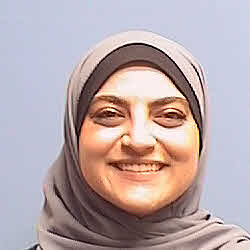Resident Supervision
The Residency Supervision Area is designed to assist hospitals and clinics with the protocols outlined for specific duties residents and fellows can perform. These guidelines are determined by the faculty of the University of Tennessee Health Science Center. Any questions about certain procedures not listed should be addressed to the faculty and not decided by the resident or fellow.
A credentialed and privileged attending physician ultimately provides supervision or oversight of each resident's patient care activities. Direct supervision by a qualified attending physician is required in the OR/Delivery Room or for non-routine invasive procedures like Cardiac Cath, Endoscopy, and Interventional Radiology. The standards for resident supervision in patient care settings are described in GME Policy #410.

Al-Sukhni, Layan - PGY - 4
Department of Dermatology
Resident Supervision
PGY 2, 3, or 4 Dermatology
trainees can perform the procedures listed below with indirect supervision:
|
|
PGY2 |
PGY3 |
PGY4 |
|
Differential
Diagnosis: |
|||
|
Clinical History |
X |
X |
X |
|
Physical Examination |
X |
X |
X |
|
Interpretation of Lab Studies |
X |
X |
X |
|
Interpretation of Basic X-ray Studies (skull, spine, chest, abdomen,
extremities) |
X |
X |
X |
|
Cardiopulmonary
Resuscitation: |
|||
|
Airway Maintenance |
X |
X |
X |
|
Emergency Drug Therapy |
X |
X |
X |
|
Rhythm Strip Interpretation |
X |
X |
X |
|
Intravenous Catheterization |
X |
X |
X |
|
Closed Chest Massage |
X |
X |
X |
|
Pediatric Resuscitation |
X |
X |
X |
|
Electrocardioversion
& Defibrillation |
X |
X |
X |
|
Intracardiac Injection |
X |
X |
X |
|
Venous Cut-down |
X |
X |
X |
|
Airway
Maintenance: |
|||
|
Insertion of Oral Pharyngeal Airway |
X |
X |
X |
|
Endotracheal Intubation |
X |
X |
X |
|
Crichothyroidotomy |
X |
X |
X |
|
Use of Mechanical Respirators |
X |
X |
X |
|
Additional
Specific Skills: |
|||
|
Intra-arterial Puncture or Catheterization |
X |
X |
X |
|
Bladder Catheterization |
X |
X |
X |
|
Foreign Body Removal Techniques |
X |
X |
X |
|
Splinting of Fractures & Dislocations |
X |
X |
X |
|
Emergency Closed Reduction Technique (followed by cast application) |
X |
X |
X |
|
I&D of Superficial Abscesses & Hematomas |
X |
X |
X |
|
Interpreting Arterial Blood Gases |
X |
X |
X |
|
Emergency Treatment of 1st, 2nd & 3rd
Degree Burns |
X |
X |
X |
|
Introduction of NG Tubes |
X |
X |
X |
|
Diagnostic Peritoneal Lavage |
X |
X |
X |
|
Preparation
and Interpretation of Microscopic Specimens: |
X |
X |
X |
|
Biopsy
of skin and mucosal surfaces (punch, shave, incisional, excisional) |
X |
X |
X |
|
Incision
and drainage of skin lesions |
X |
X |
X |
|
Excision
and skin lesions (simple) |
X |
X |
X |
|
Cryosurgical
destruction of skin lesions |
X |
X |
X |
|
Cutaneous
patch testing |
X |
X |
X |
|
Phototherapy
(UVA, UVB) |
X |
X |
X |
|
Electrosurgical
destruction of skin lesions |
|
X |
X |
|
Excision
of skin lesions (complex) |
|
|
X |
|
Phototesting |
|
X |
|
|
All other procedures are performed under
direct supervision of a faculty member. |
|||
